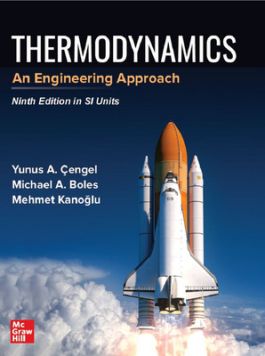Thermodynamics: An Engineering Approach
9th Edition
935316737X
·
9789353167370
© 2020 | Published: August 30, 2019
Overview Distinguished as a best seller, the title Thermodynamics: An Engineering Approach is taking another step towards excellence with this revised edition. Through its careful explanations of concepts, and use of numerous practical examples a…
Read More
Receive instant access to McGraw Hill Connect®, a comprehensive online learning platform:
- eBook, homework and adaptive assignments, and study tools
- Download the free ReadAnywhere App for offline access to your eBook
Note: Connect can only be used if assigned by your instructor.
CHAPTER ONE
INTRODUCTION AND BASIC CONCEPTS
CHAPTER TWO
ENERGY, ENERGY TRANSFER, AND GENERAL ENERGY ANALYSIS
CHAPTER THREE
PROPERTIES OF PURE SUBSTANCES
CHAPTER FOUR
ENERGY ANALYSIS OF CLOSED SYSTEMS
CHAPTER FIVE
MASS AND ENERGY ANALYSIS OF CONTROL VOLUMES
CHAPTER SIX
THE SECOND LAW OF THERMODYNAMICS
CHAPTER SEVEN
ENTROPY
CHAPTER EIGHT
ENERGY
CHAPTER NINE
GAS POWER CYCLES
CHAPTER TEN
VAPOR AND COMBINED POWER CYCLES
CHAPTER ELEVEN
REFRIGERATION CYCLES
CHAPTER TWELVE
THERMODYNAMIC PROPERTY RELATIONS
CHAPTER THIRTEEN
GAS MIXTURES
CHAPTER FOURTEEN
GAS–VAPOR MIXTURES AND AIR-CONDITIONING
CHAPTER FIFTEEN
CHEMICAL REACTIONS
CHAPTER SIXTEEN
CHEMICAL AND PHASE EQUILIBRIUM
CHAPTER SEVENTEEN
COMPRESSIBLE FLOW
APPENDIX
PROPERTY TABLES AND CHARTS
Overview
Distinguished as a best seller, the title Thermodynamics: An Engineering Approach is taking another step towards excellence with this revised edition. Through its careful explanations of concepts, and use of numerous practical examples and figures, this book aims to bridge the gap between knowledge and the confidence to properly apply it.
Key Features
• Written in a self-instructive manner, it speaks to students, not over students
• Emphasizes on the physical aspects of the subject matter in addition to mathematical representations and manipulations.
• Follows a physical, intuitive approach to help students master the practical problems
• Contains a rich pool of pedagogy which revolve around the real-world problems
Distinguished as a best seller, the title Thermodynamics: An Engineering Approach is taking another step towards excellence with this revised edition. Through its careful explanations of concepts, and use of numerous practical examples and figures, this book aims to bridge the gap between knowledge and the confidence to properly apply it.
Key Features
• Written in a self-instructive manner, it speaks to students, not over students
• Emphasizes on the physical aspects of the subject matter in addition to mathematical representations and manipulations.
• Follows a physical, intuitive approach to help students master the practical problems
• Contains a rich pool of pedagogy which revolve around the real-world problems

